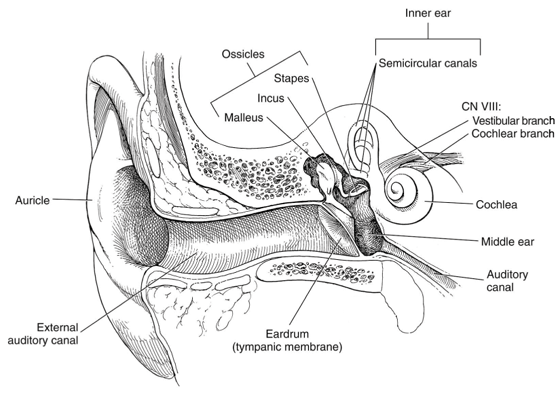Can I obtain VA disability benefits for a hearing impairment?
Yes, VA disability benefits for your hearing impairment may be available.
You will need to prove that (a) you were in the military, (b) your hearing impairment originated or was aggravated while you were on active duty, (c) you were continuously treated for your hearing impairment since leaving the service (unless you are filing your disability claim within one year of leaving the service or your condition has been chronic), and (d) you are currently disabled by your hearing impairment.
About hearing impairments
Our hearing apparatus consists of several structures:
- The external ear is the pinna. This may help deflect sound into the external auditory canal.
- The next structure is the eardrum. This is a thin and delicate membrane. Vibration of the eardrum by sound puts pressure on a series of three small bones in a space behind the eardrum called the “middle-ear.”
- The “middle-ear” bones transmit sound vibration from the eardrum to the cochlea in the inner ear.
- The cochlea is a spiral, fluid-filled bony structure lined with a membrane holding about 15,000 tiny hairs that move when vibrations in the fluid reach them.
The different hairs react to different frequencies of sound. This information is coded into the auditory nerve and transmitted to both sides of the brain, though principally to the opposite side.

Figure 1: Close-up of structures of the human ear.
Causes of hearing loss
Hearing loss can be caused by a variety of different things. Congenital defects anywhere in the hearing apparatus or brain can result in hearing loss. Infections and other diseases account for other cases. Allergies that cause fluid in the middle-ear can also result in hearing loss, if allowed to persist. Other causes of hearing loss are drugs, trauma, immune diseases, cancers, circulatory, genetic and degenerative disorders.
Most hearing loss results from problems with the cochlea or auditory (acoustic) nerve. This is called sensorineural. Hearing loss due to damage to areas of the brain cerebral cortex used in hearing is called central hearing loss. Hearing loss due to damage to the bones of the middle ear is called a conductive hearing loss. Mixed hearing loss means there is a combination of sensorineural and conductive hearing losses.
Testing of hearing
Hearing testing is done by audiometry, and is usually performed by audiologists.
Hearing is tested at several different frequencies. The ones that are important are 500, 1000, 2000, and 3000 Hertz [Hz]. The intensity of sound is measured in decibels (dB), and the decibel level at which a sound of a particular frequency can be heard is the pure tone threshold.
Ability to hear sound of 0–25 dB is normal. Normal conversation takes place in about the 45–60 dB range.
People hear by sounds conducted both through the air and sound conducted through bones in the ear and skull. Audiometry tests both types of hearing. Hearing through air is air conduction and through bone is bone conduction.
Audiometry usually includes a test of how well you can understand words, and is called speech discrimination. Speech discrimination, as determined by speech audiometry, is the percentage of test words correctly identified when spoken from standardized and pre-recorded lists. A normal person will achieve nearly 100% correct identification. This test can be used for adults and older children.
However, speech discrimination should not be confused with the speech recognition threshold (SRT), which involves a measure of the lowest decibel intensity at which test words can be heard 50% of the time. SRT is a measure of loudness and does not imply ability to understand speech. Speech discrimination is used to determine how well a patient can understand what he hears. The SRT should reasonably correlate with the pure tone average (PTA) for the 500, 1000, and 2000 Hz frequencies, and can thus serve as a check on the validity of the test. The pure tone average is by standard acceptance the sum of the decibel levels necessary to hear 500, 1000, and 2000 Hz, divided by 3. When the person being tested does not cooperate with the testing procedures, such as in malingering, there will be a substantial discrepancy between the SRT and PTA.
The audiologist who tests your hearing gradually varies the particular sound intensity (decibel level), until you state that you can hear the tone half of the time. This is the pure tone threshold sensitivity at a given frequency for you to be aware that there is a sound.





